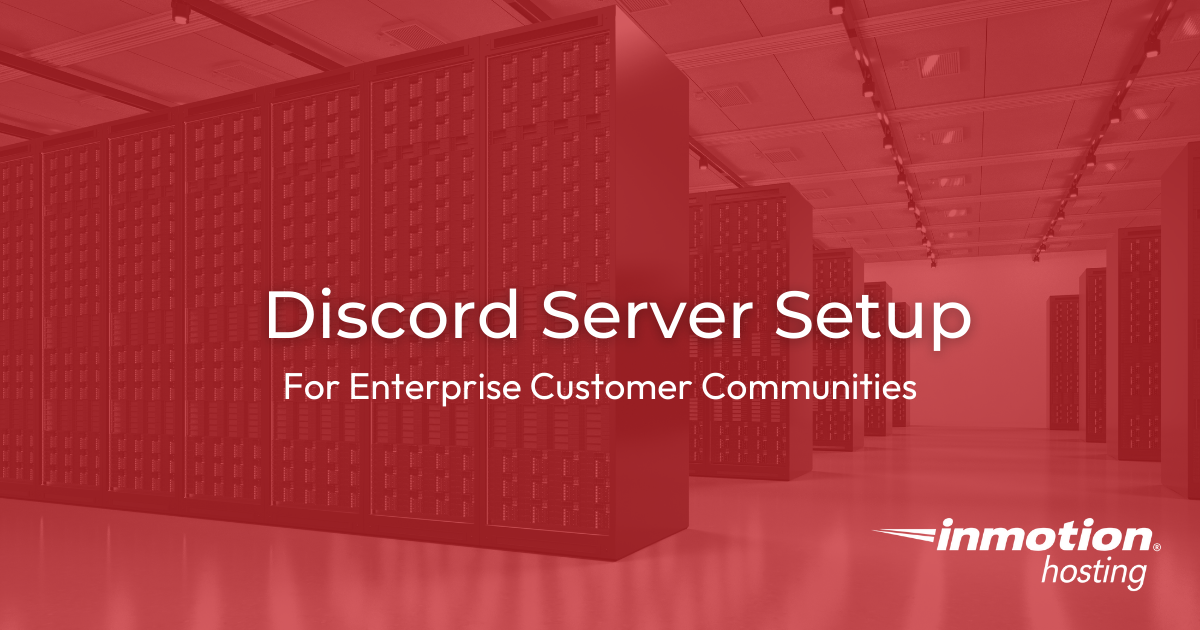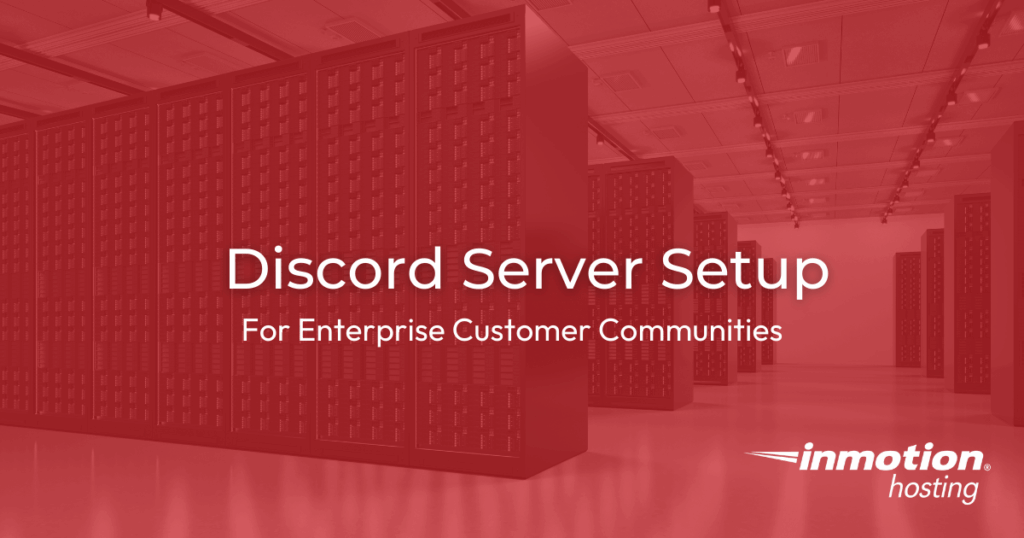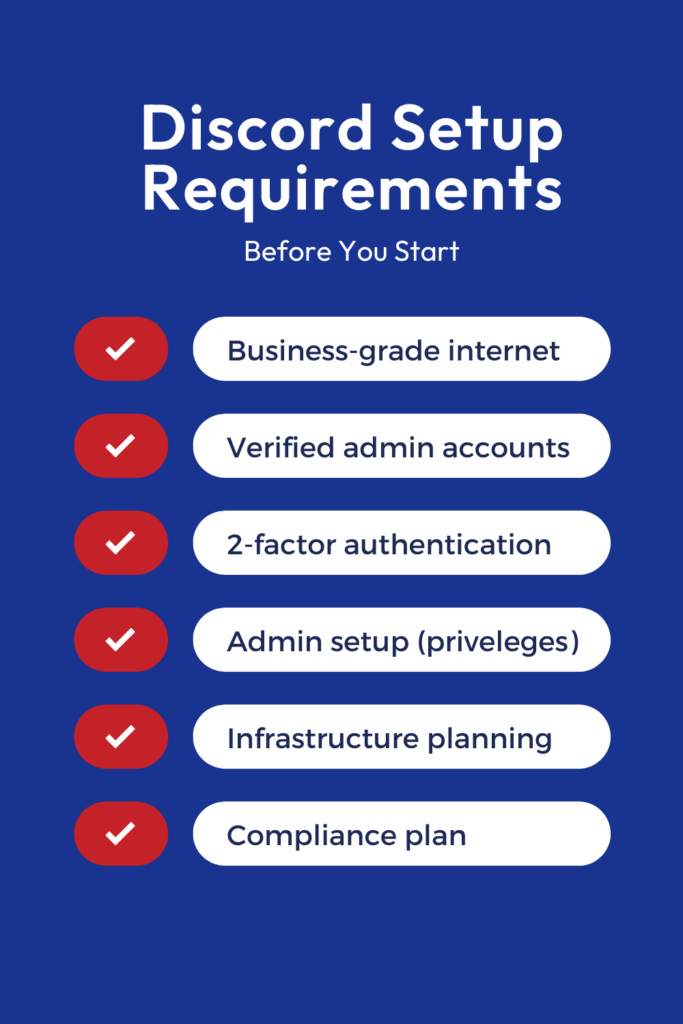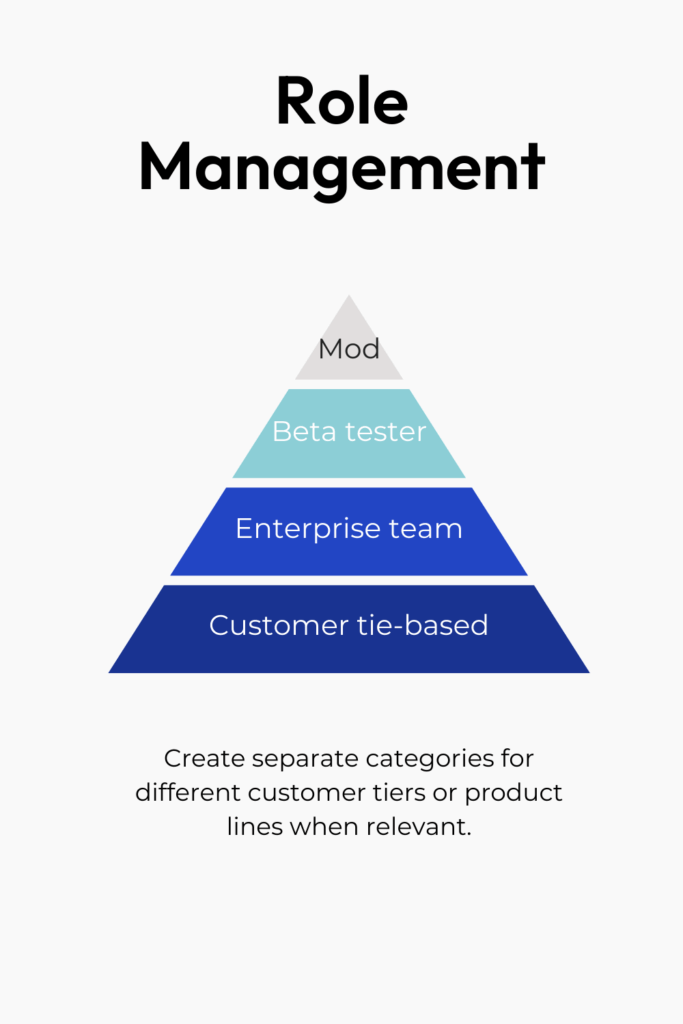
Advanced Discord System Setup | Inmotion Hosting

Are you ready to stop drowning in support tickets? Discord server setup helps businesses cut support costs while building engaged customer communities that solve problems together. This guide shows CTOs and IT leaders how to configure secure, scalable Discord servers that turn customer support from a cost center into a competitive advantage.
Your support tickets are piling up. Customer complaints about slow response times keep flooding in. Sound familiar?
Here’s the thing: traditional support forums create barriers between you and your customers. They limit the real conversations that build loyalty and drive growth.
Discord servers offer a game-changing solution. You can create vibrant customer communities that slash support costs while building stronger relationships. This guide shows you exactly how to do it.
What Is Discord Server Setup for Enterprise Customer Communities?
Discord server setup means creating dedicated spaces where your customers can get help, share ideas, and connect directly with your team. It’s different from internal team chat because it focuses on public access and customer needs.
Why does this matter for your business? Well, it’s simple: customers solve each other’s problems. This cuts your support workload while creating the kind of community that keeps people coming back.
The benefits are clear. You’ll see lower support costs, faster problem resolution, and real-time feedback on your products. Plus, customers who help each other become your biggest advocates.
Why Smart Businesses Choose Discord for Customer Communities
Let’s talk numbers. Traditional community platforms can cost $500+ monthly. Discord gives you powerful community features at zero base cost. That’s money you can invest back into your business.
Real-time engagement changes everything. Instead of waiting days for forum responses, customers get instant help. They share solutions immediately. This means that your team can jump in when needed, but the community handles most questions naturally.
Here’s what really matters: community-driven support dramatically reduces ticket volume. When customers help each other, your support team can focus on complex issues that need expert attention.
The technical side requires some planning. You’ll need reliable hosting for custom bots and integrations. Many businesses rely on VPS hosting to ensure their Discord tools run smoothly as communities grow.
Discord Server Setup Requirements You Need to Know
Firstly, before diving into Discord server setup, get your foundation right. You need business-grade internet, verified admin accounts with two-factor authentication, and clear moderation workflows.
Start with proper admin setup. Use business email addresses, not personal ones. Then, document who has admin access and create backup admin accounts. Personnel changes shouldn’t disrupt your community.
Infrastructure planning becomes critical when you add custom features. Discord bots, support system integrations, and analytics tracking need dedicated hosting. These tools require reliable uptime and room to scale.
Don’t forget compliance. You should know how Discord handles customer data and ensure it aligns with your privacy policies. We recommend that you document everything for regulatory requirements.

Step-by-Step Discord Server Setup Guide
Building Your Enterprise Server Foundation
To start, you’ll need to set up your Discord server with a business email address. Personal emails cause problems later when you need to add team members or transfer ownership. But business emails look more professional and make account management easier.
Next, pick the right server template for your needs. Discord offers many gaming templates, but you want community-focused ones instead. Don’t get stuck in the gaming template section; keep your eyes out for those created by other community builders. Look for templates with welcome areas, support sections, and announcement spaces. These work better for business customers than gaming setups.
Brand your server to match your company. Upload your company logo and write a clear server name that tells people what they’ll find. Your description should explain what customers can do in your community. This helps new visitors understand your space right away.
However, choose your server region carefully because it affects how fast your Discord works. If most customers are localized in one area, pick that region. For global customers, choose a region that works well for your biggest customer groups. Slow Discord hurts the customer experience.
Security That Protects Your Community
Proper security keeps bad users out while letting good customers join easily. Here’s what you need to set up:
- Set verification levels to “Medium” or “High”. This blocks spam accounts but lets real customers join without trouble. These settings check email addresses and ensure accounts aren’t brand new.
- Enable two-factor authentication for all staff. Turn this on for anyone who can change server settings. This adds extra protection for admins and moderators.
- Document who has access to what. Write down admin permissions and check this list regularly. Remove access for people who no longer work with you.
- Set up automatic content filtering. Use Discord’s built-in tools plus custom bots to catch spam and bad content before customers see it.
- Create an incident response plan. Know what to do when problems happen. Think about security like protecting your website with multiple layers.
Setting Up Customer Community Channels
Organize your channels around how customers think about your products. Don’t copy your internal company structure. Instead, create areas for general questions, specific product help, feature requests, and company news. This makes it easier for customers to find the right place for their questions.
Connect your Discord server setup to your existing support system. Use bots to move complex problems from Discord into your regular support tickets. This will track all customer issues while still letting the community help with simple questions. Nothing gets lost, and customers get faster help.
Link your help documents to Discord conversations. That way, customers can find your FAQ, guides, and troubleshooting tips without leaving Discord, and they solve problems faster. This helps customers and reduces work for your support team.
Plan for growth when you set up channels. Think about new products you might launch or how customer needs might change in the future. Setting up a good channel structure now prevents major changes later when your community gets bigger.
Managing Roles for Business Success
Smart role management will make your Discord server setup work better for both customers and your team. Here’s how to set up roles that drive results:
- Create customer roles that match your business. If you have different service levels, make roles for each one. If you sell different products, consider roles for different user types.
- Make your company staff clearly visible. Use different colors for employee roles and give them different permissions. Customers should know when they’re getting official help versus community advice.
- Reward your best community members. Give beta testers, active helpers, and long-time customers special access to new features or direct contact with your team.
- Set up clear moderation levels. Community volunteers handle basic issues, paid moderators deal with bigger problems, and company staff make final decisions.
- Write down the rules. Document how different situations should be handled so everyone treats customers the same way.

Discord Server Setup Tips That Drive Customer Success
Optimizing Community Engagement
- Welcome automation guides new customers through community rules, available resources, and introductory channels. You’ll want to help them find value quickly instead of wandering around confused.
- Integrate with existing CRM and support systems for seamless data flow. Support ticket creation and customer interaction tracking should maintain your operational standards.
- Develop custom bots for enterprise workflows. Automate routine tasks, provide self-service options, and collect customer feedback that integrates with your business intelligence systems.
- Monitor analytics and community health. Track engagement metrics, identify trending issues, and measure community impact on customer satisfaction and support cost reduction.
Managing Support Channels Effectively
Create ticket routing systems that automatically escalate complex issues from Discord to your support queues. Additionally, maintain conversation context and customer history throughout the process.
Encourage community-driven troubleshooting by rewarding customers who help others. For example, create knowledge-sharing incentives that reduce official support burden while building stronger relationships.
Integrate your knowledge base so searchable solutions remain accessible within Discord conversations. The idea is to help customers find existing answers before creating new support requests.
Finally, be sure to monitor performance for high-traffic communities. Watch for slower response times, connection issues, or integration failures that impact customer experience.
Customer Data and Privacy Management
Ensure GDPR compliance for global communities. Create clear privacy policies, document data processing, and establish customer consent mechanisms that align with Discord’s practices.
Define customer data retention policies. Specify how long customer interactions, support conversations, and community contributions stay in Discord servers and integrated systems.
Implement privacy controls for sensitive discussions. Include private channels for confidential issues, direct message policies for support staff, and escalation procedures for enhanced privacy situations.
Consider data sovereignty for customers in regions with specific residency requirements that may conflict with Discord’s infrastructure locations.
Advanced Discord for Business Community Features
Enterprise Integration and Automation
If you build API integrations with customer success platforms, you’ll have a great two-way data flow between Discord activity and your CRM systems. This process can give comprehensive customer engagement tracking.
Discord servers have an effective system for creating support tickets that automatically captures context, customer information, and issue details while routing problems to appropriate teams.
Hosting requirements for custom integrations often need dedicated server resources with reliable uptime guarantees. Many businesses use dedicated servers to ensure optimal performance for mission-critical community tools.
Multi-Community Management
Managing multiple product communities requires centralized moderation tools, consistent branding, and streamlined processes that scale with your product portfolio.
Moreover, cross-community communication helps customers discover related products, share expertise across areas, and maintain engagement with broader company offerings. Centralized moderation ensures consistent standards, efficient resource use, and comprehensive oversight across all Discord servers.
Resource planning for multiple communities requires infrastructure capacity planning, administrative bandwidth allocation, and technical architecture supporting growing ecosystems.
Analytics and ROI Measurement
Track Discord community engagement through active users, message volume, support issue resolution rates, and customer satisfaction indicators that demonstrate value to stakeholders.
By tracking customer satisfaction through community activity, you can identify trends in product feedback, support quality, and overall sentiment that inform business strategy.
Also, be sure to measure support cost reduction by comparing traditional ticket volumes and resolution times against community-driven problem solving. Quantify Discord community ROI clearly.
Data analysis infrastructure needs analytics platforms capable of processing Discord API data, integrating with enterprise reporting systems, and providing actionable customer community insights.
Troubleshooting Common Discord Server Setup Issues
- Permission conflicts in customer-facing servers often come from overly restrictive role configurations that prevent legitimate participation or overly permissive settings that compromise security.
- Moderation challenges with public communities include handling inappropriate content, managing conflicting customer opinions, and maintaining professional standards while preserving authentic discussions.
- Integration failures with enterprise systems frequently result from API rate limiting, authentication issues, or data format incompatibilities between Discord and existing business software.
- Community growth can exceed Discord’s native capabilities, causing performance issues, feature limitations, or scaling constraints that require alternative platform solutions.
When Discord Communities Need Enterprise Infrastructure
Scaling Beyond Discord’s Capabilities
Community size limitations appear when servers approach member limits, experience performance issues, or require features unavailable within Discord’s constraints. Likewise, custom feature requirements beyond Discord’s scope include advanced analytics, specialized integrations, or compliance features that necessitate migration to enterprise-controlled platforms.
Self-hosted community alternatives provide complete infrastructure control, unlimited customization, and integration flexibility that growing enterprises may require as communities mature. Migration strategies to enterprise-controlled infrastructure should preserve community data, maintain member engagement, and provide seamless transitions without disrupting established relationships.
Enterprise-Grade Discord Alternatives
Rocket.Chat for customer communities delivers enterprise-grade security, complete data control, and unlimited customization while providing familiar chat-based experiences. Alternatively, Mattermost serves technical product communities with advanced developer tools, extensive API capabilities, and enterprise security features supporting complex customer engagement.
Complete infrastructure ownership enables enterprises to implement specific security policies, integrate with proprietary systems, and maintain complete control over customer community data.
However, implementation complexity and hosting requirements reveal that enterprise-controlled platforms require significant technical expertise, dedicated hosting infrastructure, and ongoing maintenance resources.
Best Practices for Enterprise Discord Community Management
Regular security audits ensure ongoing customer data protection, compliance with evolving privacy regulations, and maintenance of community access controls preventing unauthorized participation.
Customer community growth strategies should balance organic expansion with quality control. Ensure new members contribute positively while maintaining the supportive atmosphere that makes communities valuable.
Infrastructure scaling for thriving communities requires proactive capacity planning, performance monitoring, and technical architecture accommodating rapid growth without compromising customer experience.
Long-term platform planning considers evolving customer needs, changing business requirements, and potential migration paths to enterprise-controlled infrastructure as communities mature.
Your Next Steps for Discord Server Setup Success
Discord server setup for enterprise customer communities provides a cost-effective foundation for building engaged customer relationships while reducing support overhead and creating valuable feedback channels.
The ROI from well-managed Discord communities typically includes reduced support ticket volumes, improved customer satisfaction, and enhanced product feedback quality that drives business growth. Support cost reductions often justify community management investments within the first year.
As customer communities grow and evolve, enterprises frequently discover the need for advanced infrastructure solutions that provide greater control, enhanced security, and unlimited customization beyond Discord’s constraints.
Ready to scale beyond Discord? Our community infrastructure experts can help you explore enterprise-grade hosting solutions that grow with your customer community’s needs.







